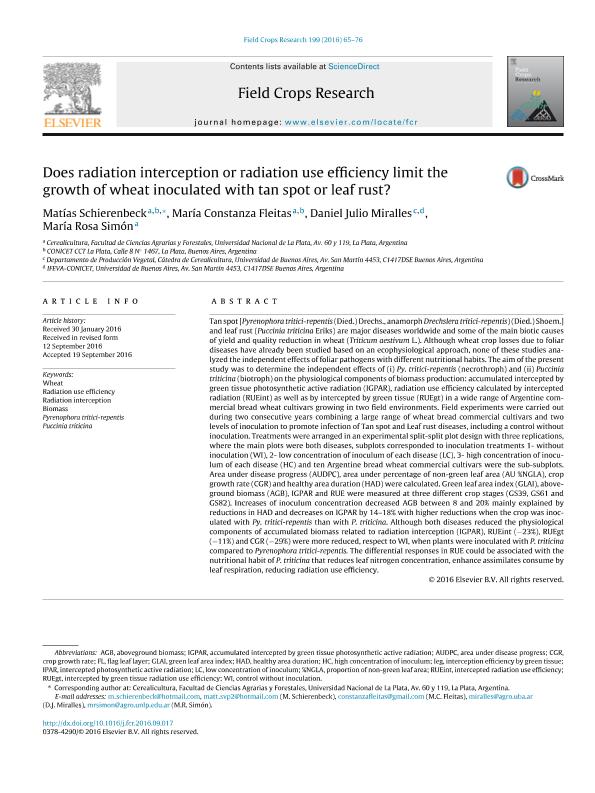Mostrar el registro sencillo del ítem
dc.contributor.author
Schierenbeck, Matías

dc.contributor.author
Fleitas, María Constanza

dc.contributor.author
Miralles, Daniel Julio

dc.contributor.author
Simon, Maria Rosa

dc.date.available
2018-06-22T17:57:42Z
dc.date.issued
2016-12
dc.identifier.citation
Schierenbeck, Matías; Fleitas, María Constanza; Miralles, Daniel Julio; Simon, Maria Rosa; Does radiation interception or radiation use efficiency limit the growth of wheat inoculated with tan spot or leaf rust?; Elsevier Science; Field Crops Research; 199; 12-2016; 65-76
dc.identifier.issn
0378-4290
dc.identifier.uri
http://hdl.handle.net/11336/49683
dc.description.abstract
Tan spot [Pyrenophora tritici-repentis (Died.) Drechs., anamorph Drechslera tritici-repentis) (Died.) Shoem.] and leaf rust (Puccinia triticina Eriks) are major diseases worldwide and some of the main biotic causes of yield and quality reduction in wheat (Triticum aestivum L.). Although wheat crop losses due to foliar diseases have already been studied based on an ecophysiological approach, none of these studies analyzed the independent effects of foliar pathogens with different nutritional habits. The aim of the present study was to determine the independent effects of (i) Py. tritici-repentis (necrothroph) and (ii) Puccinia triticina (biotroph) on the physiological components of biomass production: accumulated intercepted by green tissue photosynthetic active radiation (IGPAR), radiation use efficiency calculated by intercepted radiation (RUEint) as well as by intercepted by green tissue (RUEgt) in a wide range of Argentine commercial bread wheat cultivars growing in two field environments. Field experiments were carried out during two consecutive years combining a large range of wheat bread commercial cultivars and two levels of inoculation to promote infection of Tan spot and Leaf rust diseases, including a control without inoculation. Treatments were arranged in an experimental split-split plot design with three replications, where the main plots were both diseases, subplots corresponded to inoculation treatments 1- without inoculation (WI), 2- low concentration of inoculum of each disease (LC), 3- high concentration of inoculum of each disease (HC) and ten Argentine bread wheat commercial cultivars were the sub-subplots. Area under disease progress (AUDPC), area under percentage of non-green leaf area (AU %NGLA), crop growth rate (CGR) and healthy area duration (HAD) were calculated. Green leaf area index (GLAI), aboveground biomass (AGB), IGPAR and RUE were measured at three different crop stages (GS39, GS61 and GS82). Increases of inoculum concentration decreased AGB between 8 and 20% mainly explained by reductions in HAD and decreases on IGPAR by 14–18% with higher reductions when the crop was inoculated with Py. tritici-repentis than with P. triticina. Although both diseases reduced the physiological components of accumulated biomass related to radiation interception (IGPAR), RUEint (−23%), RUEgt (−11%) and CGR (−29%) were more reduced, respect to WI, when plants were inoculated with P. triticina compared to Pyrenophora tritici-repentis. The differential responses in RUE could be associated with the nutritional habit of P. triticina that reduces leaf nitrogen concentration, enhance assimilates consume by leaf respiration, reducing radiation use efficiency.
dc.format
application/pdf
dc.language.iso
eng
dc.publisher
Elsevier Science

dc.rights
info:eu-repo/semantics/openAccess
dc.rights.uri
https://creativecommons.org/licenses/by-nc-nd/2.5/ar/
dc.subject
Biomass
dc.subject
Puccinia Triticina
dc.subject
Pyrenophora Tritici-Repentis
dc.subject
Radiation Interception
dc.subject
Radiation Use Efficiency
dc.subject
Wheat
dc.subject.classification
Agricultura

dc.subject.classification
Agricultura, Silvicultura y Pesca

dc.subject.classification
CIENCIAS AGRÍCOLAS

dc.title
Does radiation interception or radiation use efficiency limit the growth of wheat inoculated with tan spot or leaf rust?
dc.type
info:eu-repo/semantics/article
dc.type
info:ar-repo/semantics/artículo
dc.type
info:eu-repo/semantics/publishedVersion
dc.date.updated
2018-06-22T14:39:41Z
dc.journal.volume
199
dc.journal.pagination
65-76
dc.journal.pais
Países Bajos

dc.journal.ciudad
Amsterdam
dc.description.fil
Fil: Schierenbeck, Matías. Universidad Nacional de La Plata. Facultad de Ciencias Agrarias y Forestales; Argentina. Consejo Nacional de Investigaciones Científicas y Técnicas; Argentina
dc.description.fil
Fil: Fleitas, María Constanza. Universidad Nacional de La Plata. Facultad de Ciencias Agrarias y Forestales; Argentina. Consejo Nacional de Investigaciones Científicas y Técnicas; Argentina
dc.description.fil
Fil: Miralles, Daniel Julio. Consejo Nacional de Investigaciones Científicas y Técnicas. Oficina de Coordinación Administrativa Parque Centenario. Instituto de Investigaciones Fisiológicas y Ecológicas Vinculadas a la Agricultura. Universidad de Buenos Aires. Facultad de Agronomía. Instituto de Investigaciones Fisiológicas y Ecológicas Vinculadas a la Agricultura; Argentina
dc.description.fil
Fil: Simon, Maria Rosa. Universidad Nacional de La Plata. Facultad de Ciencias Agrarias y Forestales; Argentina. Consejo Nacional de Investigaciones Científicas y Técnicas; Argentina
dc.journal.title
Field Crops Research

dc.relation.alternativeid
info:eu-repo/semantics/altIdentifier/doi/http://dx.doi.org/10.1016/j.fcr.2016.09.017
dc.relation.alternativeid
info:eu-repo/semantics/altIdentifier/url/https://www.sciencedirect.com/science/article/pii/S0378429016303392
Archivos asociados
